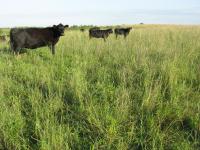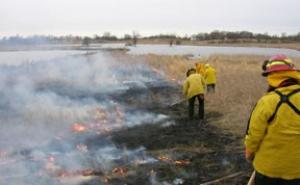What's Working for Conservation
Upland Maintenance
2013-2014 Information
Maintenance after Seeding: The following maintenance is recommended after seeding prairie: if planted in spring, apply glyphosate within 5-7 days after seeding or apply glyphosate after green-up and wait 7 days before seeding. Year 1 mow or chop aggressively after growth gets 15-18 inches tall using a stalk chopper or rotary mower. This is to control the annual weeds, if you prevent them from going to seed for a few years they will likely disappear. Year 2 mow or chop between June 1-15 as needed. Mow or burn in years 4, 5 or 6 and every 4-6 years afterward (Jason Selvog, Stearns SWCD and Dennis Pederson, Habitat Forever).
Grazing Monitoring: In sites where cattle are present, I spend time looking at what they’re eating and not eating, as well as which parts of the prairie are being grazed most and least. In our patch-burn grazing prairies, we expect most grazing to take place in recently-burned areas, so I check to see if that’s happening. Often, cattle target their favorite grass species first and then graze wildflowers only if they’ve already eaten the best parts of those grasses. If I see something other than that pattern, it can tell me a lot about our stocking rate or other issues – not necessarily in a bad way. There are also a few plant species that our cattle can’t resist (some milkweeds, rosinweeds, Canada milkvetch, and spiderwort) and we like to make sure those species get a release from grazing pressure every few years (Chris Helzer – Prairie Ecologist post on “What I Look for When I Walk Through My Prairies”)
Wetland Grazing: A pilot grazing study on a wetland banking site in Clay County has provided useful information to guide grazing efforts in wet meadow plant communities. Cattle at the site tend to focus on reed canary grass throughout the grazing season. They have also set set-back cattails when concentrated in wet areas. Rotation timing and duration are critical to success. Altering the “starting cell” from year to year also appears to produce more effective suppression (Lynn Foss, Clay SWCD).
Mowing Trees: We have had success with mowing trees with a brush hog in prairies in late summer, assisting with removal. We’ve used a John Deere 4010 that has plenty of power, but the trees are tough on the front of the tractor. It really needs to be on a front wheel assist tractor and loader with a 7 foot wide bucket to push the trees over in front of the tractor (Rich Perrine, Martin SWCD).
2008-2012 Information
Cottonwood Control: We started out only doing foliar application for cottonwood control. Our mix is: 1% Element 3, 1.5% Platoon (2,4-D amine), and 8 oz./60 gal of Freeway surfactant. It is a spreader, sticker, penetrant. When we first started, we had the 2,4-D at 1% and we think it was a little weak. Going to 1.5% reduced the time needed to see results and got a better kill. On the other hand, it’s important to be careful not to get the 2-4,D too strong because it’s possible to “shock” the tree into shutting down only to releaf/resprout. We started doing the basal application a couple years ago. We cover the whole circumference of the tree from the root flare up to about 1’ (depending on diameter). We tried the “hack and squirt” method and had very poor success. It seemed as if the mixture wouldn’t wick around the whole stem to kill it. Where the bark wasn’t “hacked” would be alive and heal over the dead area. Our method uses more product but eliminates any rework that would be needed. In the past we mixed 25% Element 3 and 75% Blue Bark Oil with great results. This fall I experimented with a 20%/80% mix. We’ll see in the spring how well this worked. But I believe it will work as well as the hotter mix. Finally, I would recommend using Element instead of Garlon. It is the same chemical at a much cheaper price (Eric Gulbransen, Steele SWCD).
Mowing During Establishment: It is common to mow first year prairie plantings to keep the agricultural weeds short and provide light to the tiny prairie seedlings emerging late in spring, especially on sites where productive soils and high rainfall amounts promote particularly vigorous weed growth. Some sites have found they only need to mow if the weed density is so high as to cause discoloration of the prairie seedlings or to prevent light from reaching the soil (Lessons Learned from the TNC Grassland Restoration Network: 2003-2010).
Prescribed Burning: Prescribed burning is typically needed about every three to five years to prevent the deterioration of prairie. Burning prevents species such as smooth brome and sumac from invading. Fall burns are typically better for setting back woody vegetation, they can also benefit early blooming prairie species such as lupine. Ideally, burning should be conducted at different times of the year over time (Dave Crawford).



